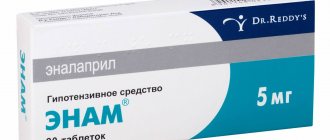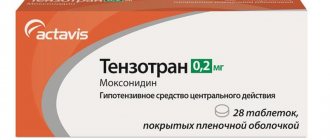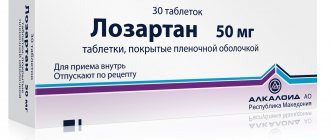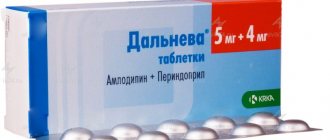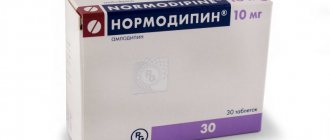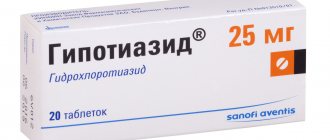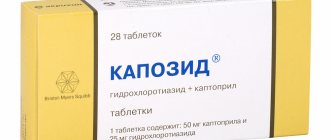Compound
One tablet contains the active ingredient enalapril maleate in an amount of 5, 10 or 20 mg.
Berlipril 5 tablets also contain additional components: lactose monohydrate, gelatin, magnesium carbonate, sodium carboxymethyl starch, silicon dioxide, magnesium stearate.
Berlipril 10 and Berlipril 20 tablets contain additional components: lactose monohydrate, gelatin, magnesium carbonate, sodium carboxymethyl starch, silicon dioxide, magnesium stearate, as well as a dye pigment in the form of iron oxide.
Pharmacokinetics of the drug
The maximum concentrations of the active substances of the drug in the blood are observed after 3-4 hours from the moment of taking the tablets. However, the therapeutic effect manifests itself much faster, due to which Berlipril significantly reduces blood pressure an hour after taking the drug.
Once in the liver area, it is transformed into active metabolites. It has good bioavailability, being absorbed by the body by 60%, regardless of the meal schedule.
The half-life is approximately 11 hours. Most of the drug (about 60%) is excreted from the body through the kidneys, along with urine, and another 33-34% through the gastrointestinal tract with feces.
Pharmacodynamics and pharmacokinetics
The active substance is enalapril . The mechanism of action is aimed at inhibiting the angiotensin-converting enzyme and reducing the formation of angiotensin-2 from the precursor angiotensin-1 (causing a decrease in aldosterone secretion).
The drug reduces diastolic and systolic blood pressure, reduces preload and afterload on the myocardium. The drug acts more actively on arteries than on veins and does not cause a reflex increase in heart rate.
The most pronounced hypotensive effect is observed with a high level of renin in the blood. Berlipril has no effect on blood circulation in the brain; it increases renal and coronary blood flow.
With long-term therapy with enalapril, a decrease in the severity of left ventricular myocardial hypertrophy is recorded, the process of left ventricular dilation slows down, and the progression of heart failure .
In damaged myocardium, enalapril improves blood supply. The drug reduces platelet aggregation.
Berlipril helps to prolong life expectancy in patients with chronic heart failure. The drug has a mild diuretic effect.
Berlipril slows the progression of glomerulosclerosis and reduces intraglomerular hypertension. The main substance is a “prodrug” from which enalaprilat is formed through the process of hydrolysis. Enalaprilat inhibits angiotensin-converting enzyme.
When administered orally, the hypotensive effect is recorded within an hour. To achieve a stable effect, the drug must be taken for a long time.
Pharmacological properties of the drug Berlipril
Pharmacodynamics. Enalapril maleate is a salt of maleic acid and enalapril. Enalapril hydrolysis occurs in the liver, resulting in the formation of its active metabolite, enalaprilat, which is an ACE inhibitor. ACE converts angiotensin I into angiotensin II, a substance that has a vasoconstrictor effect. Inhibition of ACE leads to a decrease in the formation of angiotensin II in tissues and blood plasma, a decrease in the secretion of aldosterone and an increase in renin activity in the blood plasma. Since ACE breaks down bradykinin, which has a vasodilating effect, the consequence of ACE inhibition is an increase in the activity of the kalikrein-kinin system and, thus, activation of the prostaglandin system. The use of enalapril maleate in patients with hypertension (arterial hypertension) causes a decrease in blood pressure without a compensatory increase in heart rate and a decrease in peripheral vascular resistance. In patients with heart failure, the use of enalapril maleate leads to a decrease in peripheral vascular resistance, resulting in a decrease in afterload on the heart. When treated with enalapril maleate, there is an increase in IOC, an increase in stroke index and exercise tolerance, a decrease in left ventricular hypertrophy, and an improvement in intraglomerular renal blood flow. Enalapril maleate has no effect on the metabolism of glucose and lipoproteins. Pharmacokinetics. After oral administration, up to 60% of the dose is absorbed into the gastrointestinal tract. Concomitant food intake does not affect the absorption of enalaprilat. Bioavailability is about 50–70%. The maximum concentration in the blood plasma is reached after approximately 4 hours. The effective half-life of enalaprilat after repeated oral administration is 11 hours. Effective inhibition of ACE activity occurs 2-4 hours after taking a single dose of enalapril maleate. The onset of antihypertensive action is noted after 1 hour, and the maximum effect is observed 4-6 hours after taking the drug. The duration of action depends on the dose, however, when the drug is used in recommended doses, the antihypertensive and hemodynamic effects persist for at least 24 hours. In volunteers with normal renal function, steady-state concentrations are achieved approximately on the 3rd–4th day with a dosage of 10 mg every 24 hours. In the range therapeutic doses, binding to plasma proteins does not exceed 60%. Metabolites other than enalaprilat are not known. The drug is excreted primarily by the kidneys. Renal clearance is approximately 150 ml/min. The half-life of enalaprilat is 35 hours. The main component in the urine is enalaprilat (40% of the dose taken) and unchanged enalapril maleate (about 20%). If renal function is impaired, the release of enalaprilat decreases according to the degree of dysfunction. Enalaprilat is eliminated during hemodialysis and peritoneal dialysis. Hemodialysis reduces the plasma concentration of enalaprilat by approximately 46%.
Contraindications
Berlipril is not used during pregnancy, intolerance to ACE inhibitors, enalapril, or breastfeeding.
For idiopathic and hereditary forms of angioedema , for cerebrovascular diseases, for severe systemic, autoimmune connective tissue diseases, for cerebral circulatory failure, for aortic stenosis , coronary insufficiency, HMB, for scleroderma, systemic lupus erythematosus , for stenosis of the renal arteries, for the elderly age, diabetes mellitus , hyperkalemia, inhibition of bone marrow hematopoiesis, Berlipril is used with caution after consulting a doctor.
Contraindications to the use of the drug Berlipril
Hypersensitivity to enalapril maleate, to other ACE inhibitors or to any of the components of the drug. A history of angioedema, which developed as a result of the use of ACE inhibitors, as well as hereditary idiopathic angioedema (Quincke's edema, swelling of the face, lips, tongue, larynx and/or vocal cords). Narrowing of the renal arteries (bilateral or solitary kidney); condition after kidney transplant. Narrowing of the heart valve openings or the presence of other obstructions to the outflow of blood from the left ventricle. Primary increase in aldosterone levels in the blood. Primary liver disease or dysfunction. During pregnancy and breastfeeding. There is no experience using the drug in children.
Side effects
Cardiovascular system: orthostatic collapse , angina pectoris, chest pain, myocardial infarction, excessive drop in blood pressure, pulmonary embolism, palpitations, atrial fibrillation , atrial tachycardia , atrial bradycardia, arrhythmia.
Nervous system: anxiety, paresthesia, weakness, headaches, insomnia, dizziness, depression, drowsiness, confusion, fatigue, nervousness .
Sense organs: noise in the head, hearing impairment, vestibular apparatus disorders.
Digestive tract: jaundice, pancreatitis , stool disorders, dyspeptic disorders , loss of appetite, dry mouth, epigastric pain, nausea, liver disorders, bile excretion disorders, hepatitis.
Respiratory system: shortness of breath, bronchospasm, pharyngitis, rhinorrhea, interstitial pneumonitis , “dry” non-productive cough.
Allergic response: angioedema of the lips, face, tongue, skin rashes, dysphonia , laryngeal edema, epidermal toxic necrolysis, exudative, erythema multiforme, exfoliative dermatitis, vasculitis, serositis, photosensitivity, urticaria , glossitis , stomatitis , arthritis, arthralgia, myositis.
Urinary system: proteinuria , renal dysfunction.
Possible development of eosinophilia, libido disorders, agranulocytosis , eosinophilia, neutropenia, decreased hematocrit, hyperkalemia, alopecia.
What does Berlipril help with?
Medical experts recommend that patients take Berlipril for high blood pressure if the following clinical indications exist:
- Arterial hypertension;
- Scleroderma;
- Symptomatic and renovascular form of hypertension;
- Chronic heart failure.
Berlipril for hypertension is also prescribed for preventive purposes to patients suffering from dysfunction of the left cardiac ventricle to prevent the development of coronary-ischemic processes.
Berlipril tablets, instructions for use (Method and dosage)
In accordance with the instructions for use, Berlipril is taken regardless of meals.
Monotherapy for arterial hypertension: initial dosage 5 mg per day. If there is no effect, the dose is increased by 5 mg after 1-2 weeks. After prescribing the drug, the patient is observed for two hours until blood pressure is completely stabilized. If well tolerated, the dosage is increased to 40 mg per day, the dose is divided into 2 doses.
The average daily dosage for moderate arterial hypertension is 10 mg. The maximum daily amount of the drug is 40 mg. Diuretic drugs are discontinued 2-3 days before Berlipril is prescribed.
For renovascular hypertension, the initial dosage is 2.5-5 mg per day.
In case of severe arterial hypertension, intravenous administration of enalaprilat under inpatient observation is permissible. For low systolic pressure, treatment begins with 1.25 mg.
Dosing of the drug is carried out over 2-4 weeks. If there is a severe drop in blood pressure, the dosage of the drug is reduced gradually.
Depending on the dose, it is convenient to use certain types of the drug: Berlipril 5, Berlipril 10, Berlipril 20.
Overdose of the drug Berlipril
There is only limited information regarding overdose in humans. The most likely sign of overdose is severe arterial hypotension, occurring approximately 6 hours after taking the tablets, and simultaneous blockade of the renin-angiotensin-aldosterone system with the development of a stuporous state. With an overdose of ACE inhibitors, circulatory failure, loss of electrolytes, renal failure, hyperventilation, tachycardia, increased heart rate, bradycardia, dizziness, fear and cough may develop. Treatment: IV infusion of sodium chloride solution is recommended. If there is a sharp decrease in blood pressure, the patient must be placed in a horizontal position with the lower limbs raised. Infusion of angiotensin II and/or catecholamines is advisable. If the tablets have been taken recently, the stomach should be rinsed and sorbents should be used. Enalaprilat is removed by dialysis. For resistant bradycardia, the use of an artificial pacemaker is indicated. It is necessary to constantly monitor the level of electrolytes and creatinine in the blood serum. Treatment of angioedema . The development of angioedema of the face, lips, tongue, larynx, and extremities can occur at any time during therapy. In these cases, the drug should be discontinued and the patient observed. If swelling on the face and lips is limited, the use of antihistamines is necessary. Swelling of the tongue, glottis and larynx can be life-threatening and requires emergency treatment, such as subcutaneous injection of 0.3–0.5 mg epinephrine (1:1000 dilution) and/or airway management .
Overdose
Manifested by stupor, convulsions, troboembolic complications , acute cerebrovascular accidents, myocardial infarction, and excessive drop in blood pressure.
It is urgent to place the patient in a horizontal position, with the head lowered below the level of the body. Gastric lavage and oral use of saline solution are effective; in severe cases, treatment measures should be aimed at stabilizing blood pressure through intravenous infusion of plasma substitutes and sodium chloride solution.
Enalaprilat is excreted during hemodialysis at a rate of 62 ml per minute. If necessary, angiotensin-2 is infused intravenously and hemodialysis is performed.
Pharmacological action of Berlipril
According to the instructions, Berlipril belongs to the group of ACE inhibitors (angiotensin-converting enzyme inhibitors). Penetrating into the human body, the drug undergoes hydrolysis, resulting in the formation of an active substance called enalaprilat. This component inhibits the enzyme that converts angiotensin 1 into angiotensin 2. It is the latter element that has a powerful vasoconstrictor effect and also stimulates the production of aldosterone, which causes the retention of water and sodium ions in the body. Enalaprilat also slows down the destruction of bradykinin, which produces a vasodilator effect and increases the production of prostaglandins - substances that dilate blood vessels.
As a result, Berlipril helps reduce total vascular peripheral resistance. Thus, diastolic and systolic blood pressure, post- and preload on the heart muscle are reduced. The active component of the drug improves coronary and renal blood flow.
From the instructions for Berlipril, patients can learn that the medicine has a hypotensive effect and also prevents the increase in heart failure.
Regardless of meals, the drug is absorbed by 60% in the digestive organs. The metabolic process occurs in the liver.
Enalapril and enalaprilat are excreted from the body mainly through the kidneys, but also in small amounts through feces.
Interaction
Berdipril slows down the process of removing lithium from the body and increases the effects of ethanol.
The drug weakens the effect of medications that contain theophylline .
Other antihypertensive drugs, diuretics enhance, and estrogens and NSAIDs reduce the hypotensive effect.
When using potassium-sparing drugs and diuretics, the likelihood of hyperkalemia increases, which leads to agranulocytosis , neutropenia, and bone marrow suppression.
Cytostatics, allopurinol , immunosuppressants increase hematotoxicity.
Drug interactions Berlipril
Potassium-sparing diuretics and potassium supplements. Enalapril maleate reduces potassium loss caused by diuretics. Its simultaneous use with spironolactone, triamterene, amiloride, potassium preparations or potassium-containing salt substitutes can lead to a significant increase in serum potassium levels. Diuretics. The use of diuretics in high doses prior to the initiation of enalapril maleate therapy may lead to the development of hypotension. The hypotensive effect can be reduced by stopping the diuretic, compensating for the lack of fluid and/or salts in the body, or starting Berlipril therapy using a low dose. Other antihypertensive drugs . Combination use with antihypertensive drugs of other groups, nitroglycerin and/or other nitrates or vasodilators may enhance the antihypertensive effect of enalapril maleate. Lithium. The simultaneous use of enalapril maleate and lithium preparations is not recommended due to increased lithium levels in the blood serum. If this combination is necessary, serum lithium levels should be carefully monitored. Tricyclic antidepressants/neuroleptics/anesthetics and anesthetics. The antihypertensive effect of enalapril maleate may be enhanced. NSAIDs. When used in combination, the antihypertensive effect of enalapril maleate may be weakened. There may be a synergistic effect on serum potassium levels, leading to hyperkalemia and reversible deterioration of renal function. AKI may develop, especially in patients with signs of dehydration or in the elderly. Sympathomimetics. The antihypertensive effect of enalapril maleate may be weakened. Hypoglycemic agents. It is possible to enhance the effect of insulin and oral hypoglycemic drugs when used simultaneously with enalapril maleate, up to the development of hypoglycemia. This is especially possible in the first weeks of combination therapy, as well as in patients with impaired renal function. With simultaneous consumption of alcohol, the effect of enalapril maleate is enhanced. Acetylsalicylic acid/thrombolytic agents/β-adrenergic receptor blockers . There are no contraindications for the combination of enalapril maleate with these drugs.
special instructions
When treating patients with reduced blood volume (vomiting, diarrhea, hemodialysis, limited salt intake, diuretic therapy), caution must be exercised due to the risk of a sharp drop in blood pressure. Once blood pressure has stabilized, the diagnosis of transient hypotension is not a contraindication to enalapril therapy.
The risk of developing anaphylactic reactions increases when using dialysis, high-flow membranes. Correction of the dosage regimen is carried out depending on blood pressure indicators. Monitoring blood counts and protein levels in the urine is required.
Patients with cerebral vascular diseases, decompensated forms of CHF, and coronary artery disease require careful monitoring, since a sharp drop in pressure can cause renal stroke, myocardial infarction, and disturbances in the functioning of the renal system.
When you suddenly stop taking enalapril, withdrawal syndrome is not recorded.
Oliguria requires support for renal perfusion , stabilization of blood pressure, administration of vasoconstrictors and appropriate fluids.
For patients with pathologies of the renal system, it is recommended to increase the time between doses of the drug Berlipril and reduce the dosage.
Before conducting examinations of the functions of the parathyroid glands, the drug is discontinued.
In hot weather and intense physical activity, caution is required.
Before performing surgical treatment, it is imperative to warn the anesthesiologist and surgeon about taking enalapril.
The drug affects driving.
Berlipril 20
Use during pregnancy and breastfeeding
The use of Berlipril® during pregnancy is contraindicated.
Patients planning pregnancy should be switched to an alternative treatment with a proven safety profile for use in pregnant women. If pregnancy is confirmed, use of Berlipril should be discontinued immediately and, if necessary, alternative therapy should be initiated. The use of ACE inhibitors in the second and third trimesters of pregnancy was accompanied by negative effects on the fetus, including the development of arterial hypotension, renal failure, hyperkalemia and/or hypoplasia of the skull bones in the newborn. Oligohydramnios may develop, apparently due to decreased fetal renal function. This complication can lead to contracture of the limbs, deformation of the bones of the skull, including its facial part, and hypoplasia of the lungs. When using the drug Berlipril®, it is necessary to inform the patient about the potential risk to the fetus. If it is impossible to discontinue the drug Berlipril® during pregnancy, careful monitoring of newborns whose mothers took Berlipril® is necessary to identify a possible decrease in blood pressure, oliguria and hyperkalemia, monitor the state of renal function, as well as the skull bones of the newborn using ultrasound.
Enalapril and enalaprilat are excreted into breast milk in trace amounts, but their safety has not been studied. If it is necessary to use the drug during lactation, breastfeeding should be discontinued.
Enalapril can be removed from the neonatal circulation using peritoneal dialysis; theoretically - through exchange blood transfusion.
Use for liver dysfunction
Berlipril should be prescribed with caution in case of liver failure.
Use for renal impairment
In chronic renal failure, drug accumulation occurs when filtration decreases to less than 10 ml/min. With a CC of 80-30 ml/min, the dose of Berlipril is usually 5-10 mg/day, with a CC of 30-10 ml/min - 2.5-5 mg/day, with a CC <10 ml/min - 1.25-2.5 mg/day only on dialysis days.
Berlipril should be prescribed with caution in case of renal failure (proteinuria more than 1 g/day).
Use in children
Contraindication: children and adolescents under 18 years of age.
Use in elderly patients
Berlipril should be prescribed with caution to elderly patients (over 65 years of age).
special instructions
Caution must be exercised in patients with reduced blood volume (including when used simultaneously with diuretics, in conditions of limited salt intake, hemodialysis, diarrhea, vomiting), in whom a sudden and pronounced decrease in blood pressure may develop in response to the use of an ACE inhibitor . In patients with mild chronic heart failure, with or without chronic renal failure, symptomatic hypotension is usually not observed. The development of arterial hypotension is most likely in patients with more severe chronic heart failure due to the use of high doses of diuretics, hyponatremia, or functional renal failure. In these patients, treatment should begin under the supervision of a physician until the optimal dose adjustment of Berlipril® and/or diuretic. Similar tactics can be applied to patients with coronary artery disease and cerebrovascular diseases, in whom an excessive drop in blood pressure can lead to myocardial infarction or cerebral stroke. If severe arterial hypotension develops, the patient should be placed in a horizontal position and, if necessary, an IV infusion of saline should be started.
Transient arterial hypotension is not a contraindication for continuing treatment with enalapril after stabilization of blood pressure. In case of a repeated pronounced decrease in blood pressure, the dose should be reduced or the drug discontinued. Before starting and during treatment with ACE inhibitors, dynamic monitoring of blood pressure, some biochemical and electrolyte blood parameters (concentration of hemoglobin, potassium ions, sodium ions, creatinine, urea, liver enzymes in the blood serum), as well as urine for the presence of protein is necessary.
As with all vasodilators, ACE inhibitors should be used with caution in patients with left ventricular hypertrophy and valvular obstruction and should be avoided in cases of cardiogenic shock and hemodynamically significant obstruction.
In cases of impaired renal function (creatinine clearance < 80 ml/min), careful monitoring of serum potassium and creatinine concentrations is necessary. In patients with renal failure, it may be necessary to reduce the dose and/or frequency of dosing.
In some patients with bilateral renal artery stenosis or stenosis of the artery of a solitary kidney, increases in serum urea and creatinine concentrations were observed. The changes were usually reversible and returned to normal after cessation of treatment.
In some patients who did not have renal disease before treatment, slight and transient increases in serum urea and creatinine concentrations were observed when enalapril was used concomitantly with diuretics. In such cases, it may be necessary to reduce the dose and/or discontinue enalapril and/or diuretic.
There is an increased risk of arterial hypotension and renal failure in patients with bilateral renal artery stenosis or arterial stenosis of a solitary kidney who are treated with ACE inhibitors. Only moderate changes in serum creatinine concentration may indicate a decrease in renal function. In these patients, treatment should begin with small doses under close medical supervision, precise gradual selection of the individual dose and monitoring of serum creatinine concentrations.
There is no experience with the use of Berlipril® in patients who have recently undergone kidney transplantation. Therefore, treatment of such patients with this drug is not recommended.
The use of Berlipril® in patients with liver failure usually does not require dose adjustment. Rarely, taking ACE inhibitors is associated with a syndrome ranging from the development of cholestatic jaundice to the development of fulminant liver necrosis. If symptoms of jaundice or increased liver enzyme activity occur in patients taking ACE inhibitors, discontinue drug therapy and conduct appropriate evaluation.
There are reports of the development of life-threatening anaphylactic reactions in patients receiving ACE inhibitors during a desensitization procedure with hymenoptera (heminoptera) venom. Such reactions can be avoided if the ACE inhibitor is temporarily stopped before desensitization begins. The use of ACE inhibitors should be avoided in patients receiving bee venom immunotherapy.
Neutropenia, agranulocytosis, thrombocytopenia, and anemia can develop during therapy with ACE inhibitors. With normal renal function and the absence of other complications, neutropenia rarely occurs.
ACE inhibitors are prescribed only in emergency cases when the patient has systemic connective tissue diseases, during immunosuppressive therapy, in cases of simultaneous use of allopurinol or procainamide, as well as in a combination of all of these factors, especially against the background of existing renal failure.
Some of these patients developed severe infections, which in some cases did not respond to intensive antibiotic therapy. If enalapril is used in such patients, periodic monitoring of the white blood cell count is recommended, and patients should be appropriately instructed to promptly report any signs of infection to the physician.
Cough has been reported during treatment with ACE inhibitors. Usually the cough is non-productive and persistent and stops after discontinuation of the drug. Cough due to treatment with ACE inhibitors should be considered in the differential diagnosis of cough.
There have been reports of angioedema (Quincke's edema) of the face, extremities, lips, tongue, glottis and/or larynx in patients receiving ACE inhibitors, incl. Berlipril®, during different periods of treatment. In such cases, treatment with Berlipril should be stopped immediately and proper medical supervision should be carried out until the corresponding symptoms disappear completely. Even in cases where only difficulty swallowing occurs without difficulty breathing, patients should be under medical supervision for a long time, since therapy with antihistamines and corticosteroids may not be sufficient. Angioedema of the larynx or tongue can be fatal. Swelling of the tongue, vocal folds or larynx can lead to airway obstruction; appropriate therapy, including subcutaneous injection of 0.1% epinephrine solution (0.3-0.5 ml) and/or measures to ensure airway conduction, should be carried out as soon as possible.
In patients of the Negroid race, the incidence of angioedema when using ACE inhibitors is higher than in representatives of other races. Like other ACE inhibitors, enalapril appears to be less effective in lowering blood pressure in black patients than in others, possibly due to the high prevalence of low renin in this population of patients with hypertension.
During the treatment period, it is not recommended to drink alcoholic beverages, because alcohol enhances the hypotensive effect of the drug.
In patients undergoing surgery or general anesthesia with the use of drugs that lower blood pressure, enalapril may block the formation of angiotensin II under the influence of compensatory renin release. If it is assumed that arterial hypotension develops by this mechanism, it can be corrected by increasing the volume of blood volume. Before surgical interventions (including dental procedures), it is necessary to warn the surgeon/anesthesiologist about the use of Berlipril®.
In rare cases, life-threatening anaphylactoid reactions have been observed in patients taking ACE inhibitors during LDL apheresis with dextran sulfate. If LDL apheresis is used, ACE inhibitors should be temporarily replaced with drugs for the treatment of hypertension or heart failure from other groups.
Anaphylactoid reactions have been observed in patients undergoing dialysis using high-flow membranes (eg, AN69®) while receiving ACE inhibitors. Therefore, for such patients, it is recommended either to use a different type of dialysis membrane or to use a different group of antihypertensive drugs.
In patients with diabetes mellitus taking oral hypoglycemic agents or insulin, blood glucose concentrations should be carefully monitored during the first month of treatment with enalapril.
In some patients taking ACE inhibitors, incl. enalapril, there is an increase in the concentration of potassium ions in the blood serum. The risk group for developing hyperkalemia includes patients suffering from renal failure or diabetes mellitus, taking potassium-sparing diuretics or potassium-containing salt substitutes, or other drugs that increase the concentration of potassium ions in the blood serum (for example, heparin). If the use of the above medications during treatment with Berlipril® is necessary, regular monitoring of the concentration of potassium ions in the blood serum is recommended. Like other ACE inhibitors, enalapril may be less effective in lowering blood pressure in blacks compared to other races, possibly due to lower renin levels in hypertensive patients in this population.
Sudden cessation of treatment with enalapril does not lead to the development of withdrawal syndrome (a sharp rise in blood pressure).
Impact on the ability to drive vehicles and operate machinery
Caution must be exercised when driving vehicles and engaging in potentially hazardous activities that require increased concentration and speed of psychomotor reactions (dizziness may occur due to a sharp decrease in blood pressure, especially after taking the initial dose of enalapril in patients taking diuretics).
Berlipril's analogs
Level 4 ATC code matches:
Dilaprel
Prenesa
Enap
Diroton
Lipril
Renipril
Parnavel
Fozinap
Tritace
Enam
Zokardis
Fosinopril
Lisinopril
Captopril
Monopril
Renitek
Hartil
Phosicard
Amprilan
Ramipril
Analogues include: Invoril , Renitek , Ednit , Enagexal , Enalapril , Enalozid , Enam , Enap .
Analogs
If for some reason it is necessary to make a replacement, then at the pharmacy you can buy drugs with a similar substance and at a price suitable for the patient.
A drug such as Berlipril has domestic and foreign analogues:
| Analogue | A country | Price, rub.) |
| Enalapril | Russia | from 13 |
| Ednit | Hungary | from 125 |
| Enap | Slovenia | from 80 |
| Renitek | Russia | from 39 |
| Enam | India | from 26 |
Berlipril price, where to buy
The price of Berlipril 5 is 90 rubles per pack of 30 pieces.
Berlipril 10 costs 130 rubles for the same package.
The price of Berlipril 20 is approximately 190 rubles.
- Online pharmacies in RussiaRussia
- Online pharmacies in UkraineUkraine
- Online pharmacies in KazakhstanKazakhstan
ZdravCity
- Berlipril 5 tablets 5 mg 30 pcs. Berlin-Chemie
82 rub. order - Berlipril Plus tablets 25mg+10mg 30 pcs. Berlin-Chemie AG
RUB 278 order
- Berlipril 10 tablets 10 mg 30 pcs.Berlin-Chemie
108 RUR order
- Berlipril 20 tablets 20 mg 30 pcs.Berlin-Chemie
RUB 173 order
Pharmacy Dialogue
- Berlipril plus (tab. 25 mg + 10 mg No. 30) Berlin-Chemie AG/Menarini
RUB 264 order
- Berlipril 5 (5 mg tablet No. 30)Berlin-Chemie AG/Menarini
82 RUR order
- Berlipril 20 (tab. 20 mg No. 30)Berlin-Chemie AG/Menarini
164 RUR order
- Berlipril 10 (tab. 10 mg No. 30)Berlin-Chemie AG/Menarini
111 rub. order
show more
Pharmacy24
- Berlipril 20 mg No. 30 Menarini von Heyden GmbH/ Berlin Chemi AG (Menarini Group), Nimechchina/Nimechchina
90 UAH.order - Berlipril plus 10 mg/25 mg N30 tablets Berlin Chemi AG, Nimechchina
88 UAH order
- Berlipril 10 mg No. 30 tablets Menarini von Heyden GmbH/Berlin Chemi AG (Menarini Group), Nimecchina/Nimecchina
58 UAH order
- Berlipril 5 mg No. 30 tablets Menarini von Heyden GmbH/ Berlin Chemi AG (Menarini Group), Nimecchina/Nimecchina
39 UAH order
PaniPharmacy
- Berlipril plus tablets Berlipril Plus 10/25 tablets. N30 Germany, Berlin-Chemie
99 UAH order
- Berlipril tablets Berlipril tablets. 20 mg No. 30 Germany, Berlin-Chemie
92 UAH order
- Berlipril tablets Berlipril tablets. 5mg No. 30 Germany, Berlin-Chemie
45 UAH order
- Berlipril tablets Berlipril tablets. 10 mg No. 30 Germany, Berlin-Chemie
62 UAH.order
show more
Adverse reactions
Berlipril to reduce blood pressure may cause the following adverse reactions:
- Irregular heart rhythm (arrhythmia);
- Excessive decrease in blood pressure;
- Dry cough;
- Angina;
- Nausea;
- Dyspeptic disorders;
- Painful sensations localized in the chest area;
- Stool disorders (constipation or diarrhea);
- Permanent lack of appetite;
- Headache:
- Depressive states;
- Bradycardia (slow heartbeat);
- Deterioration of hearing function;
- Swelling;
- Allergic skin rashes;
- Paresthesia;
- Psycho-emotional instability, anxiety, nervousness, irritability;
- Attacks of dizziness;
- Chronic fatigue syndrome;
- Dysphonia;
- Stomatitis;
- Swelling of the larynx;
- Dyspnea;
- Bronchial spasms;
- Arthritis;
- Disturbances in the functioning of the renal apparatus.
Any unwanted reactions that occur while taking the pills must be reported to a specialist! You may need to adjust the dosage or select a more suitable analogue!
Berlipril is one of those blood pressure medications that can cause coughing.
Drug interactions
The combination of Berlipril with diuretics and potassium supplements increases the risk of developing hyperkalemia, which threatens the patient with bone marrow damage and neutropenia.
Combination with nonsteroidal anti-inflammatory drugs and estrogens significantly reduces the hypotensive effect of the drug.
The simultaneous use of Berlipril tablets with diuretics and other antihypertensive medications, on the contrary, increases the risks of an excessive decrease in blood pressure and the development of a hypotensive crisis.
Berlipril reduces the effectiveness of drugs containing theophylline, which should be taken into account when calculating the optimal dosage.
How to replace Berlipril for high blood pressure
The following analogues of Berlipril are presented on the modern pharmaceutical market:
- Enalozide;
- Dilaprel;
- Invoril;
- Enam;
- Diroton;
- Renitek;
- Prenesa;
- Enagexal;
- Enalapril;
- Enap.
Berlipril for high blood pressure is a very effective drug that quickly improves the patient’s condition and reduces the risk of developing complications characteristic of hypertension. Like other antihypertensive drugs, you should take the tablets as prescribed by your doctor, following the recommended dosage!
